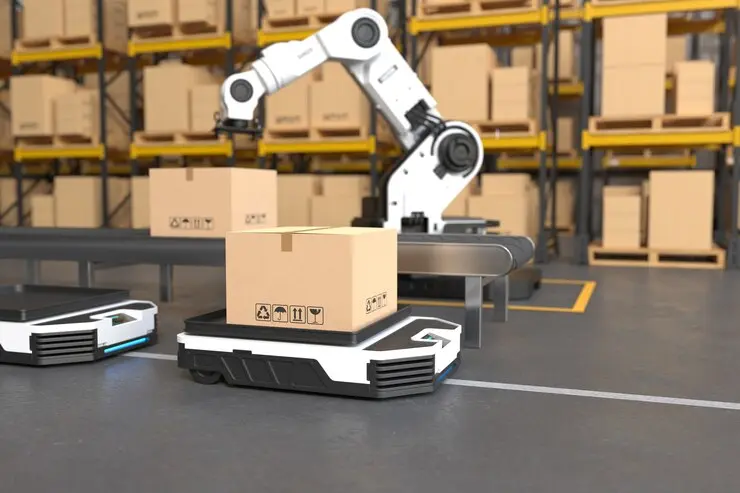Efficient Warehouse Solutions for Your E-Commerce: How a Modern E-Commerce Warehouse Works
In the dynamic world of e-commerce, efficient warehouse management is crucial for the success of an online shop. A modern e-commerce warehouse offers comprehensive solutions for inventory management and order fulfillment, specifically tailored to the needs of online retail. In this post, you will learn how such a warehouse functions and what advantages it offers your business.
A modern e-commerce warehouse is much more than just a storage location. It is the heart of the supply chain, ensuring that products are efficiently stored, managed, and delivered to customers on time. The integration of the latest technology and optimized processes allows for seamless order processing, reduces errors, and increases customer satisfaction.
The Essential Functions of a Modern E-Commerce Warehouse
- Automated Systems: From receiving goods to picking and packing, many processes are automated, increasing speed and accuracy.
- Inventory Management: Using Warehouse Management Systems (WMS), inventories are monitored in real-time, allowing precise planning and tracking.
- Scalability: The warehouse can flexibly respond to seasonal fluctuations and growing order volumes.
- Returns Management: Efficient processes for the return and refurbishment of products are integrated.
E-Commerce Warehouse: The Best Strategies and Tips
A well-organized e-commerce warehouse is the backbone of a successful online shop. Here are some proven strategies and tips to help you optimize your warehouse processes:
Automation
Automation is a key element for an efficient e-commerce warehouse. It reduces manual errors, speeds up order processing, and lowers operating costs in the long run. Some examples of automation in the warehouse are:
- Automated Storage Systems: These systems automatically move goods from one storage location to another, reducing the need for human labor.
- Pick-and-Pack Robots: Robots handle the picking and packing of orders, speeding up the process and increasing accuracy.
- Barcode Scanners and RFID Technology: These technologies enable quick and accurate recording of inventory and order status.
Storage Space Optimization
Efficient use of available storage space is crucial for smooth warehouse management. Strategies for storage space optimization include:
- Strategic Placement: Frequently sold products should be stored in easily accessible locations to minimize picking time.
- Shelving Systems: Modern, adjustable shelving systems allow maximum utilization of vertical and horizontal space.
- Lean Management Principles: Applying lean principles can reduce unnecessary movements and the need for extra storage space.
Inventory Management
A robust inventory management system is essential to avoid shortages and overstock. Here are some methods to improve inventory management:
- Real-Time Monitoring: Real-time inventory monitoring systems help keep track of current stock levels.
- Demand Forecasting: Using data analysis and algorithms to forecast demand can help you plan your orders better.
- First-In-First-Out (FIFO): This principle ensures that the oldest stock is sold first, preventing obsolescence and spoilage.
Employee Training
Well-trained employees are another key to the success of an e-commerce warehouse. Regular training and education ensure that your team is always up to date with the latest technology and procedures. Focus areas for training should include:
- Technology Usage: Training on the use of WMS and automation technologies.
- Safety Protocols: Regular training on safety and emergency protocols to avoid accidents.
- Efficiency Techniques: Introduction to proven methods and techniques to increase efficiency and reduce errors.
Sustainability
Sustainability is playing an increasingly important role in modern warehouse operations. Environmentally friendly practices not only help reduce operating costs but also improve your company’s image. Sustainability measures can include:
- Energy-Efficient Lighting: The use of LED lighting systems significantly reduces energy consumption.
- Sustainable Packaging Materials: Use recyclable or biodegradable packaging materials.
- Optimization of Transport Routes: Planning efficient transport routes and methods can reduce CO2 emissions.
By implementing these strategies and tips in your e-commerce warehouse, you can significantly increase the efficiency and profitability of your business. A well-organized warehouse leads to faster order processing, lower operating costs, and more satisfied customers.
Why an E-Commerce Warehouse Is Crucial for the Success of Your Online Shop
An efficient e-commerce warehouse can make the difference between success and failure in online retail. It ensures smooth order processing, fast delivery times, and high customer satisfaction. Here are the main reasons why a professional warehouse is crucial:
Faster Order Processing
Optimized processes and modern technologies enable faster processing and shipping of orders. Automated systems such as warehouse robots and advanced Warehouse Management Systems (WMS) help significantly reduce order turnaround times. This means that customers receive their orders faster, increasing their satisfaction and loyalty.
Cost Efficiency
A well-managed warehouse helps reduce storage costs and avoid losses due to stock shortages or overstock. By implementing efficient inventory management systems, companies can accurately monitor and control stock levels. This not only reduces storage costs but also minimizes the risk of products expiring or remaining unused.
Scalability
Flexibility and scalability are guaranteed to respond to seasonal demand fluctuations and business growth. An efficient warehouse management system can easily adapt to changing volumes, whether by expanding storage capacities or adjusting processes. This enables companies to respond to market changes without significant delays or additional costs.
Customer Satisfaction
On-time and error-free deliveries increase customer satisfaction and loyalty. When customers receive their orders reliably and promptly, it strengthens their trust in your company. Furthermore, precise and efficient warehouse processes minimize errors, reducing return rates and associated costs.
In 5 Steps to an Efficient E-Commerce Warehouse
Building an efficient e-commerce warehouse requires careful planning and implementation. Here are the five most important steps:
1. Needs Analysis
The first step is to determine the specific requirements of your business. This includes a detailed analysis of the type and quantity of products to be stored, order volumes, and expected growth patterns. A thorough needs analysis helps you choose the right systems and processes tailored to your business goals and customer expectations.
2. Layout Planning
An optimal warehouse layout is crucial for efficiency. Develop a layout that enables short distances and quick access. Consider factors such as product categories, picking frequency, and required storage space. A well-thought-out layout minimizes unnecessary movements and increases productivity.
3. Technology Integration
Modern warehouse management software (WMS) and automation solutions are essential components of an efficient warehouse. Implement technologies such as barcode scanners, RFID systems, and automated storage systems to improve the accuracy and speed of warehouse processes. These technologies enable real-time inventory monitoring and simplify order processing.
4. Process Optimization
Continuous analysis and improvement of your warehouse processes are crucial to ensure efficiency and accuracy. Identify bottlenecks and inefficiencies in existing workflows and implement best practices for process optimization. This can be achieved through regular audits, the use of lean management principles, and the application of key performance indicators (KPIs).
5. Employee Training
Well-trained employees are another key to success. Train your staff regularly to ensure they are familiar with the latest technologies and procedures. Focus areas for training should include the use of WMS, safety protocols, and efficiency techniques. Regular further training helps keep employees motivated and engaged, which in turn increases the overall efficiency of the warehouse.
By implementing these steps, you can build an efficient e-commerce warehouse that positions your business for long-term success in online retail. A well-organized warehouse leads to faster order processing, lower operating costs, and more satisfied customers, ultimately increasing the competitiveness and profitability of your business.
The Future of Parcel Delivery Services: Trends and Innovations
Parcel delivery services are constantly evolving to meet the growing demands of e-commerce. Key trends and innovations include:
Drone Deliveries
Unmanned aerial vehicles, better known as drones, are revolutionizing the logistics industry. They have the potential to drastically reduce delivery times and reach hard-to-access areas that are difficult to deliver to with conventional transportation methods. Drones can quickly and efficiently deliver small packages directly to customers, which is especially beneficial in densely populated cities or remote rural areas. Technological advancements and regulatory adjustments will further drive the use of drones in the coming years.
Autonomous Vehicles
Self-driving delivery vans and transport vehicles reduce the dependency on human drivers and increase the efficiency of supply chains. Autonomous vehicles can operate around the clock, reducing delivery times and costs. These vehicles are equipped with advanced sensors and navigation systems that enable them to drive safely and reliably. Combined with AI-powered route planning, autonomous vehicles can optimize delivery traffic and avoid congestion.
Sustainable Delivery Options
The pressure on companies to implement more environmentally friendly practices is steadily increasing. Sustainable delivery options include the use of low-emission or electric delivery vehicles and environmentally friendly packaging materials. By switching to renewable energy sources and using recyclable materials, companies can improve their carbon footprint and reduce the ecological impact of their supply chains. Such measures are not only good for the environment but can also enhance brand perception and customer satisfaction.
Same-Day Delivery
The demand for immediate delivery is increasing, posing new logistical challenges. Same-day delivery requires highly coordinated logistics and flexible warehousing to process and ship orders in the shortest possible time. This requires not only excellent inventory management and fast order processing but also strategically placed warehouses and fulfillment centers close to customers. Technologies such as real-time tracking and optimized route planning play a crucial role in this.
Cost Reduction Strategies
Efficient warehouse management can significantly contribute to reducing operating costs. Here are some tips on how to reduce your warehouse costs:
Inventory Optimization
Precise inventory control is crucial to avoid overstock and shortages. By using advanced inventory management systems, companies can monitor inventory in real-time and automate reordering. This reduces the risk of stockouts and excessive inventory, lowering storage costs and minimizing capital tied up in inventory.
Automation
Investing in automation technologies can minimize manual errors and increase efficiency. Automated systems such as conveyors, sorters, and picking robots accelerate warehouse processes and increase accuracy. This leads to faster turnaround times and lower labor costs. Additionally, automation can improve working conditions and reduce the risk of accidents.
Outsourcing
Consider whether it is more cost-effective to outsource certain warehouse processes to external service providers. External providers often have specialized expertise and infrastructure that enable them to handle warehouse processes more efficiently and cost-effectively. By outsourcing, companies can reduce their operating costs and focus on their core competencies.
Energy Savings
Opt for energy-efficient lighting and heating systems to reduce operating costs. The use of LED lighting and energy-efficient heating and cooling systems can significantly reduce energy consumption. In addition, solar panels and other renewable energy sources can be used to further reduce energy costs. An energy-efficient warehouse infrastructure not only helps reduce costs but also supports the company’s sustainability goals.
By implementing these measures, companies can significantly reduce their warehouse costs while increasing the efficiency and sustainability of their warehouse processes. Well-managed warehouse management is the key to a successful and competitive e-commerce operation.
Trends That Will Revolutionize Your Warehouse Operations
Warehouse logistics are facing numerous changes driven by technological innovations and changing market demands. Some of the key trends include:
Artificial Intelligence (AI)
AI-powered systems can optimize warehouse processes and make predictions about demand and inventory. By using algorithms for data analysis, AI can identify patterns and trends that can be used to optimize inventory and order processes. For example, AI can help predict which products will be in higher demand at certain times, allowing companies to adjust their inventory accordingly. Additionally, AI can optimize resource usage and make warehouse workflows more efficient.
Internet of Things (IoT)
The Internet of Things (IoT) is revolutionizing warehouse logistics by connecting devices and systems. IoT sensors provide real-time insights into inventory and operations. These sensors can provide information about temperature, humidity, location, and the condition of goods, allowing precise monitoring and management. With IoT, companies can identify and address potential problems early before they lead to major disruptions. Additionally, device connectivity enables automatic reordering of goods when inventory levels are low.
Robotics
Warehouse robots are taking over more tasks and increasing efficiency. From picking and packing to transporting goods within the warehouse, robots can handle repetitive and physically demanding tasks. This reduces the workload of employees and minimizes errors. Modern robots can also adapt to different tasks and be used flexibly. By using robots, companies can significantly improve their warehouse capacities and turnaround times.
Big Data
Analyzing large data sets helps make informed decisions and improve processes. By collecting and evaluating data from various sources, companies can gain insights into their warehouse operations and identify optimization potential. Big Data allows companies to recognize trends, measure process efficiency, and make predictions about future developments. By using Big Data, companies can continuously adjust and improve their warehouse strategy to stay competitive.
From Order to Delivery: How an E-Commerce Warehouse Delights Your Customers
An excellent customer experience starts in the e-commerce warehouse. Every step, from order to delivery, must run smoothly to delight your customers. Here are some aspects that play a role in this:
Fast Processing
Ensure that orders are processed quickly and efficiently. This includes the fast capture of orders, quick picking of products, and rapid packing and shipping. A well-organized warehouse layout and automated processes can significantly reduce processing times. This helps ensure that customers receive their orders faster, increasing their satisfaction and loyalty.
Transparency
Provide your customers with transparent information about order status and delivery times. Customers appreciate being informed about the progress of their orders. Real-time tracking and notifications allow customers to see the status of their delivery at any time. Transparency builds trust and increases customer satisfaction as customers know exactly when to expect their orders.
Quality Assurance
Ensure that the ordered products arrive in perfect condition. This includes careful packaging to avoid damage during transport and regular quality controls in the warehouse. By ensuring that products meet customer expectations, you can minimize returns and negative reviews.
Return Processes
Implement simple and customer-friendly return procedures. A straightforward return process is crucial for customer satisfaction. Ensure that customers can easily understand how to return products and provide clear instructions and support. An efficient return process can help strengthen customer trust and increase their loyalty.
The Role of an E-Commerce Warehouse in International Online Retail
In international online retail, the e-commerce warehouse plays a central role. It must be able to handle the complex requirements of cross-border deliveries. Key aspects include:
Customs Clearance
Efficient processes for handling customs formalities and import regulations are crucial. A well-organized warehouse must be able to quickly and accurately process all required documents and permits to avoid delays and additional costs. This requires in-depth knowledge of international trade rules and close cooperation with customs authorities.
International Shipping Options
Collaborating with reliable international shipping providers is essential. An efficient warehouse should have partnerships with logistics companies that can ensure fast and secure international deliveries. This includes selecting shipping methods that meet customer requirements and comply with the legal regulations of destination countries.
Cultural Differences
Considering regional preferences and shopping habits is important for success in the international market. An e-commerce warehouse should be able to adapt products and services to the cultural and regional specifics of target markets. This may require adjustments in packaging, marketing, and customer service to meet the expectations of international customers.
Currency Management
Integrating systems to handle various currencies and payment methods is necessary to facilitate international trade. A modern e-commerce warehouse should be able to process transactions in different currencies and offer flexible payment options. This helps simplify the purchase process for international customers and increase the conversion rate.
A well-managed e-commerce warehouse is the key to success in the international market. It helps satisfy global customers and promotes the growth of your business. By considering these aspects, you can optimize your warehouse processes and position your company for international trade.
FAQs
-
What is E-Commerce? Examples and Explanation
E-commerce, or electronic commerce, refers to the buying and selling of goods and services over the internet. Examples of e-commerce include: Online Shops: Websites like Amazon, eBay, and Etsy, where consumers can purchase products directly. Service Platforms: Websites like Uber, Airbnb, and Fiverr that facilitate online service transactions. B2B Platforms: Websites like Alibaba and TradeKey that enable trade between businesses. Digital Products: Websites like iTunes and Audible, where digital content such as music, books, and software are sold. -
What Does an E-Commerce Service Do?
An e-commerce service offers a variety of services to support online sales, including: Webshop Design and Development: Creation and maintenance of online shops. Payment Processing: Providing secure payment methods and gateways. Warehousing and Shipping: Storage of products and handling shipping logistics. Customer Service: Managing customer inquiries and issues. Marketing and SEO: Enhancing online shop visibility and increasing traffic through search engine optimization and online advertising. -
What is an E-Commerce Warehouse?
An e-commerce warehouse is a warehouse specifically designed for online retail, offering comprehensive solutions for inventory management and order fulfillment. It is equipped with modern technologies to efficiently process orders and optimize the supply chain. -
What Are the Advantages of an E-Commerce Warehouse?
An e-commerce warehouse offers numerous advantages: Efficiency: Automated processes and modern technologies speed up order processing. Scalability: Flexibility to respond to seasonal demand fluctuations and growth. Cost Reduction: Lowering storage costs and minimizing losses due to stock shortages. Customer Satisfaction: Faster and more accurate deliveries increase customer satisfaction and loyalty. -
How Does a Modern E-Commerce Warehouse Work?
A modern e-commerce warehouse functions through the integration of the latest technologies and optimized processes: Automated Systems: Many processes, from receiving goods to picking and packing, are automated. Warehouse Management Systems (WMS): Real-time monitoring of inventory allows precise planning and tracking. Returns Management: Efficient processes for the return and refurbishment of products are integrated. -
What Technologies Are Used in E-Commerce Warehouses?
Various technologies are used in e-commerce warehouses, including: Automated Storage Systems: These systems automatically move goods from one storage location to another. Pick-and-Pack Robots: Robots handle the picking and packing of orders. Barcode Scanners and RFID Technology: These technologies enable quick and accurate recording of inventory and order status. -
Why is Automation Important in E-Commerce Warehouses?
Automation is important because it: Reduces Errors: Minimizes manual mistakes. Increases Efficiency: Speeds up order processing and shipping. Lowers Costs: Reduces operating costs by decreasing the need for manual labor and speeding up processes. -
How Can Storage Space Utilization Be Optimized in an E-Commerce Warehouse?
Storage space utilization can be optimized by: Strategic Placement: Storing frequently sold products in easily accessible locations. Modern Shelving Systems: Adjustable shelving systems maximize vertical and horizontal space. Lean Management Principles: Reducing unnecessary movements and storage space needs. -
What Are the Best Strategies for Inventory Management in an E-Commerce Warehouse?
The best strategies include: Real-Time Monitoring: Systems for real-time monitoring of inventory. Demand Forecasting: Data analysis and algorithms for demand prediction. First-In-First-Out (FIFO): Principle ensuring that the oldest stock is sold first to prevent obsolescence and spoilage. -
How Can Employee Training Contribute to the Efficiency of an E-Commerce Warehouse?
Employee training contributes to efficiency by: Technology Usage: Training on the use of WMS and automation technologies. Safety Protocols: Regular training on safety and emergency protocols. Efficiency Techniques: Introduction to proven methods to increase efficiency and reduce errors. -
What Role Does Sustainability Play in E-Commerce Warehouses?
Sustainability plays an important role through: Energy-Efficient Lighting: Use of LED lighting systems. Sustainable Packaging Materials: Use of recyclable or biodegradable packaging materials. Optimization of Transport Routes: Planning efficient transport routes to reduce CO2 emissions. -
How Does an E-Commerce Warehouse Help Reduce Costs?
An e-commerce warehouse helps reduce costs by: Optimizing Inventory: Avoiding overstock and shortages. Automation: Reducing manual errors and increasing efficiency. Energy Savings: Using energy-efficient lighting and heating systems -
What Trends and Innovations Influence the Future of Parcel Delivery Services?
Future trends and innovations include: Drone Deliveries: Reducing delivery times and reaching hard-to-access areas. Autonomous Vehicles: Reducing dependence on human drivers and increasing efficiency. Sustainable Delivery Options: Environmentally friendly packaging and low-emission vehicles. Same-Day Delivery: Increased demand for immediate delivery requires flexible warehousing and fast order processing. -
How Can E-Commerce Warehouses Increase Customer Satisfaction?
Customer satisfaction can be increased by: Fast Processing: Efficient and quick order processing. Transparency: Transparent information about order status and delivery times. Quality Assurance: Ensuring products arrive in perfect condition. Return Processes: Simple and customer-friendly return procedures. -
Why is an E-Commerce Warehouse Crucial for the Success of an Online Shop?
An e-commerce warehouse is crucial because it: Fast Order Processing: Optimized processes enable quick processing and shipping. Cost Efficiency: Lowering storage costs and minimizing losses due to stock shortages. Scalability: Flexibility to respond to seasonal demand fluctuations and growth. Customer Satisfaction: Faster and error-free deliveries increase customer satisfaction and loyalty. -
How Can an E-Commerce Warehouse Operate Internationally and What Are the Challenges?
An internationally operating e-commerce warehouse must: Customs Clearance: Efficient processes for handling customs formalities and import regulations. International Shipping Options: Collaboration with reliable international shipping providers. Cultural Differences: Considering regional preferences and shopping habits. Currency Management: Integration of systems to handle various currencies and payment methods. -
What Steps Are Necessary to Build an Efficient E-Commerce Warehouse?
The steps include: Needs Analysis: Determining the specific requirements of the business. Layout Planning: Developing an optimal warehouse layout. Technology Integration: Implementing modern warehouse management software and automation solutions. Process Optimization: Continuous analysis and improvement of warehouse processes. Employee Training: Regular training on the use of technologies and procedures. -
How Can Drone Deliveries Improve Logistics in E-Commerce Warehouses?
Drone deliveries can improve logistics by: Reducing Delivery Times: Faster delivery of orders. Reaching Hard-to-Access Areas: Delivery in regions difficult to reach with conventional transportation. Reducing Traffic Congestion: Alleviating road traffic by using the airspace. -
What Advantages Do Autonomous Vehicles Offer for E-Commerce Warehouses?
Autonomous vehicles offer the following advantages: 24/7 Operation: Autonomous vehicles can operate continuously without breaks. Reduced Operating Costs: Less need for personnel and more efficient route planning. Increased Delivery Speed: Faster and more reliable delivery through optimized routes and continuous operation. -
How Is Big Data Used in E-Commerce Warehouse Management?
Big Data is used by: Analyzing Large Data Sets: Collecting and evaluating data from various sources. Optimizing Warehouse Processes: Identifying optimization potentials and trends. Predicting Future Developments: Using data to forecast demand and inventory requirements. -
What Are the Key Functions of a Warehouse Management System (WMS)?
The key functions include: Real-Time Monitoring: Monitoring and managing inventory in real-time. Inventory Control: Precise tracking of goods received and shipped. Order Processing: Efficient handling and picking of orders. Returns Management: Handling and processing returns. -
How Can Returns Be Efficiently Managed in an E-Commerce Warehouse?
Efficient returns management includes: Clear Return Processes: Simple and transparent instructions for customers. Fast Processing: Quick handling and refurbishment of returns. Integration with WMS: Using the Warehouse Management System to track and manage returns. -
What Environmentally Friendly Practices Can Be Implemented in E-Commerce Warehouses?
Environmentally friendly practices include: Energy-Efficient Lighting: Use of LED lighting systems. Sustainable Packaging Materials: Use of recyclable or biodegradable packaging materials. Optimization of Transport Routes: Planning efficient transport routes to reduce CO2 emissions. -
How Can Real-Time Inventory Monitoring Be Implemented in E-Commerce Warehouses?
Real-time inventory monitoring can be implemented by: Using RFID Technology: Quick and accurate tracking of inventory. Integration with WMS: Real-time updates and monitoring through the Warehouse Management System. Automated Systems: Using sensors and automated storage systems for continuous monitoring. -
What Challenges Are There in Integrating New Technologies in E-Commerce Warehouses?
Challenges in integrating new technologies include: Cost: High investment costs for new technologies. Compatibility: Ensuring new systems are compatible with existing infrastructures. Training: Need to train employees to handle new technologies. Security: Protecting sensitive data and ensuring cybersecurity.














